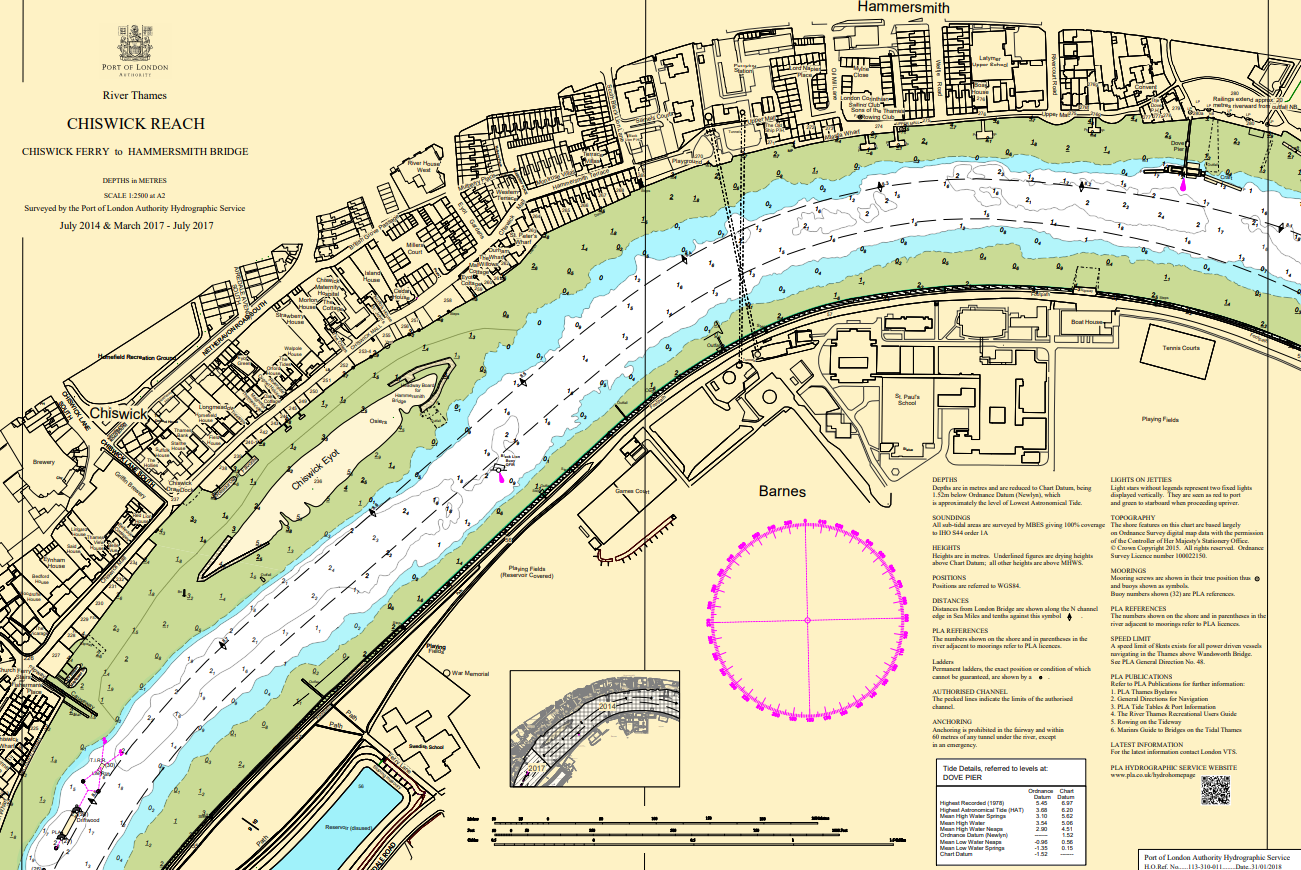Live Tides
NOTICES TO MARINERS
Charts & Surveys

Incident reporting
Life-threatening emergencies on the river:
Call 999 and ask for the Coastguard
For near miss, safety observations and incident reporting click below
Nine Elms Reach - Thames Tideway Tunnel Heathwall Pumping Station - CSO Diversion
| Notice Ref | M65-25 |
| Issuer | Cathryn Spain |
| Issuer Role | Senior Harbour Master |
| Issue Date | 02/05/2025 |
| Expiration Date | 31/12/2025 |
| District | Middle |
| Reach(es) | Nine Elms Reach |
Mariners are advised that from 19th May 2025 Tideway Tunnel contractors working on Heathwall Pumping Station site will start work to divert the flow to the river through the new Combined Sewer Outfall (CSO) location.
The CSO may discharge rain-water and untreated sewage into the river whenever there is, or has recently been, rain in the local catchment area. The discharge amount and velocity will vary, but during a storm this could be around 6 knots, lessening further from the outfall.
Lower powered and less manoeuvrable vessels should be aware of the possibility of cross currents and adjust their passage accordingly (example modelled flow velocities are included at the end of this Notice). Human powered recreational craft are advised not to pass the area in front of the CSO when there is a discharge occurring.
At times a second existing discharge, located further into the river, may also discharge. Mariners should note the location of the second discharge (marked on PLA charts and highlighted on the chartlet) from the South West Storm Relief (SWSR) and proceed with caution.
.png)
The chartlet below shows the site and the location of the new CSO in red.
A set of warning lights will be mounted vertically in front of a black backboard above the CSO. The location of the light is shown on the chartlet (shown as a black star).
The lights will flash a yellow alternating 1 second pattern, visible day and night at a range of up to 200m, whenever the CSO is discharging or likely to discharge.
Tideway advise the lights will in most cases activate at least 4 minutes before any discharge occurs. However, if the Tunnel is shut during a storm this may be reduced. Therefore, if the lights are flashing, human powered craft are advised not to pass directly in front of the site as the warning time may not be sufficient to clear the area before a discharge occurs. If mariners do need to pass when the light is flashing it is advised they enter the navigation channel, when safe to do so, until past the site.
.png)
.png)
CSO discharge alerts and warnings will be broadcast by London VTS on Ch 14. Additionally, the live status of each CSO is available on the PLA website, www.pla.co.uk/cso-status.
Routine VTS broadcasts will also include a warning if Tideway inform us there is a likelihood there will be a discharge from the site within the next hour.
Human powered recreational craft, lower powered vessels and craft engaged in towing are advised to avoid the area over the slack water period (around 2 hours over low water and around 1 hour over high water), or if there has been heavy rain and to be vigilant if there is a Met Office weather warning for rain or storms in force for the London area.
The CSO is partly connected to the tunnel which will intercept most of the discharges, but any larger storms and rain downpours may result in a discharge directly into the river. The Tunnel is expected to be in full service later in 2025. A new Notice will be issued at a later date to advise of permanent Tideway Tunnel operations.
All mariners are advised to exercise caution when passing the site and to pay attention to warnings given.
Further information on the characteristics of the CSO discharges, assessments of risk and potential impacts on mariners, which were undertaken by Tideway’s designers, are available on their website. Go to *www.tideway.london/contact-us/document-library* and follow the link to *CSO DISCHARGES - RISK TO NAVIGATION*. Mariners should consult these documents when passage planning.
(This link will take you to a third-party website which does not belong to the Port of London of Authority and may have different security, privacy and accessibility standards.)
Example discharge plumes and velocities in m/sec for a 15 year return period discharge (1 m/sec = 1.94 knots) |
|
30 minutes before Low Water slack (Difference in depth-averaged currents) |
|
10 minutes before Low Water slack (Difference in depth-averaged currents) |
|
Low Water slack (Difference in depth-averaged currents) |
|
Low Water slack (Depth-averaged currents) |
|
10 minutes after Low Water slack (Difference in depth-averaged currents) |
|
30 minutes after Low Water slack (Difference in depth-averaged currents) |
Last updated: 2025-12-10 14:02:36
Discover


.png)
.png)
.png)
.png)
.png)
.png)
